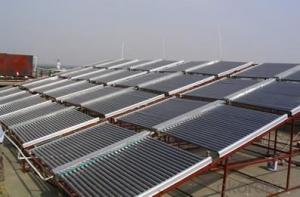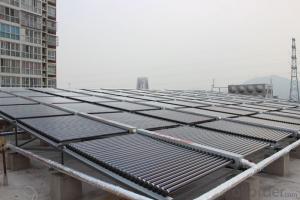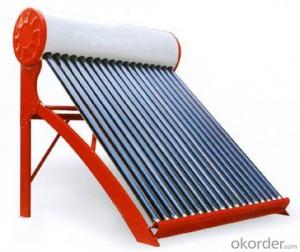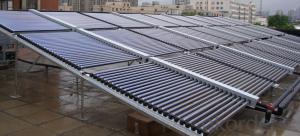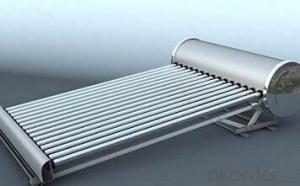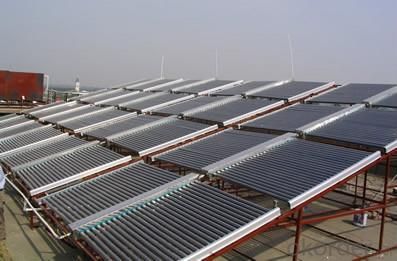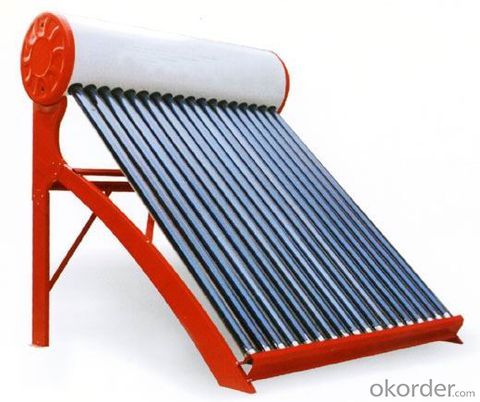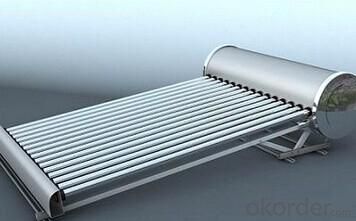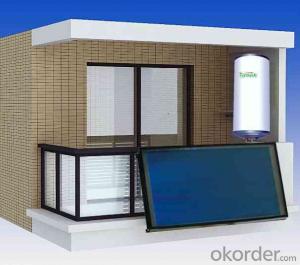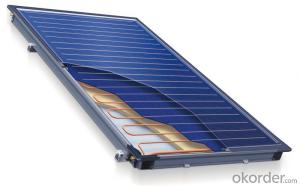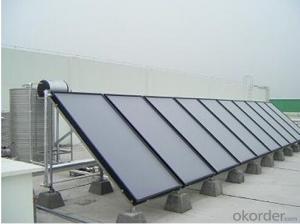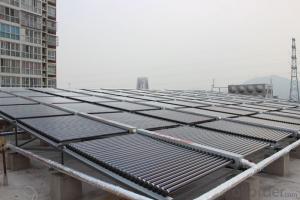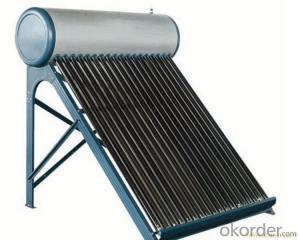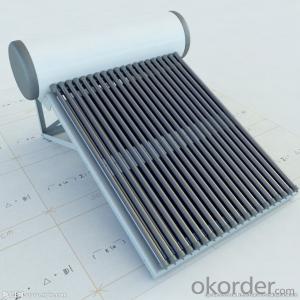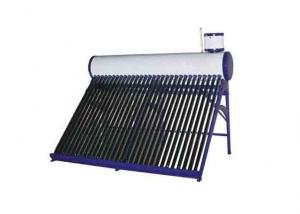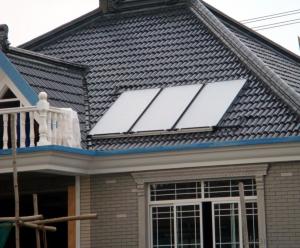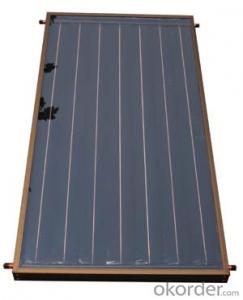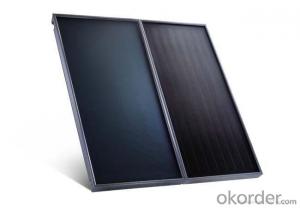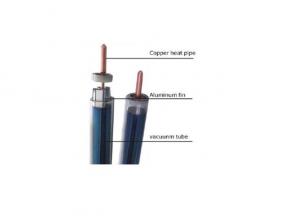Pavement Solar Collectors Pressurized Heat Pipe Solar Water Heater System New Designed
- Loading Port:
- China main port
- Payment Terms:
- TT OR LC
- Min Order Qty:
- 1 set
- Supply Capability:
- 6000 set/month
OKorder Service Pledge
OKorder Financial Service
You Might Also Like
Introduction of Non-Pressure Solar Water Heater:
Non-pressure Solar Heater is one of the most economical solar water heating device with pretty high efficiency at the same time. It consists of hot water storage tank, solar vacuum tubes with mouth plug in storage tank, and bracket supporting tank and tubes.When cold water in evacuated tubes is heated with solar irradiation, as the specific gravities of hot water and cold water are different, hotter water goes upward to storage tank and colder water goes downward to glass tubes. through this continuous circulation, the cold water in storage tank will be gradually heated till sunset.
Specialty:
1. High thermal performance and working temperature: the heat exchanging rate even in winter can up above 55%.
2. Heat collecting efficiency is at least 20% above common solar systems.
3. Work in all day and all season: no matter any corner of the world, this system can work well even -40℃ to avoid the tube freezing problem.
4. Reliability: No water following through the tube, so water scale can not generate and tube cracks could be avoided, the system still can keep working even with some damaged tubes.
5. It can connect with water tap and work automatically with pressure0.6Mpa, bring enjoyable washing experience.
6. Safety: P/T valve would release pressure and temperature to protect tank..
Technical Specification:
1. Outer tank material: SUS304 stainless steel or powder coated color steel
2. Inner tank material: 1.2mm thick SUS304 food grade stainless steel ( Optional material SUS316L)
3. Vacuum tube material: borosilicate glass 3.3; AL-SS-CU absorb coating, with copper heat pipe inside
4. Frame material: 1.2mm thickness stainless steel
5. Insulation material: 55mm thickness polyurethane
6. Suitable for mains pressure water(up to 8 bar/116psi)
7. Easy plug-in installation
8. Install the T/P valve on the pressurized tank
9. Seal material: Stabilized High Temperature Silicon
Outer tank material: SUS304 stainless steel or powder coated color steel
Inner tank material: 1.2mm thick SUS304 food grade stainless steel ( Optional material SUS316L)
Vacuum tube material: borosilicate glass 3.3; AL-SS-CU absorb coating, with copper heat pipe inside
Frame material: 1.2mm thickness stainless steel
Insulation material: 55mm thickness polyurethane
Suitable for mains pressure water(up to 8 bar/116psi)
Easy plug-in installation
Install the T/P valve on the pressurized tank
Seal material: Stabilized High Temperature Silicon
19. Vacuum Tube | 20. Size (mm) | 21. Φ47*1500 / Φ58*1800 / Φ70*2100 | |||||
22. Tube (pcs) | 23. 10 / 12 / 15 / 18 / 20 / 22 / 24 / 30 / 36 / 42 | ||||||
24. Material | 25. Borosilicate 3.3 glass, magnetron spluttering selective coating | ||||||
26. Coating | 27. Single-target AL-N/AL or Three-target AL/N-Cu-SS | ||||||
28. Water Tank | 29. Capacity | 30. 80L ~ 500L for hot water storage tank | |||||
31. Inner tank | 32. Food-grade stainless steel SUS304-2B / SUS316 | ||||||
33. Insulation | 34. High-density polyurethane foam with 70~80 hour heat preservation | ||||||
35. Tank shell | 36. Food-grade stainless steel SUS304-2B | ||||||
37. Bracket | 38. Shaped strong aluminum alloy structure adaptable for flat or slope roof | ||||||
39. Accessories | 40. Anti-aging silicon seals, Dustproof seals, Air-vent cap, Stainless screws | ||||||
41. Auxiliary Devices | 42. Assistant tank, Intelligent controller, Electrical heater, Magnesium anodes | ||||||
43. Tilt Angle | 44. 25 ~ 50° | ||||||
45. Water Output | 46. 45 - 95°C | ||||||
47. Hail Resistance | 48. Φ25mm diameter | ||||||
49. Model Number | 50. Solar Vacuum Tube | 51. Tank 52. Liter | 53. System 54. Liter | 55. Container Loading Qty /sets | |||
56. Size /mm | 57. Qty /pcs | 58. 20GP | 59. 40GP | 60. 40HQ | |||
61. VNS-58SA12-100 | 62. Φ58*1800 | 63. 12 | 64. 100 | 65. 132 | 66. 58 | 67. 119 | 68. 140 |
69. VNS-58SA15-130 | 70. 15 | 71. 130 | 72. 170 | 73. 54 | 74. 108 | 75. 131 | |
76. VNS-58SA18-150 | 77. 18 | 78. 150 | 79. 198 | 80. 43 | 81. 86 | 82. 105 | |
83. VNS-58SA20-170 | 84. 20 | 85. 170 | 86. 223 | 87. 40 | 88. 80 | 89. 97 | |
VNS-58SA24-200 | 24 | 200 | 263 | 35 | 70 | 85 | |
VNS-58SA30-250 | 30 | 250 | 329 | 28 | 56 | 68 | |
VNS-58SA36-300 | 36 | 300 | 395 | 23 | 47 | 57 | |
Product Show
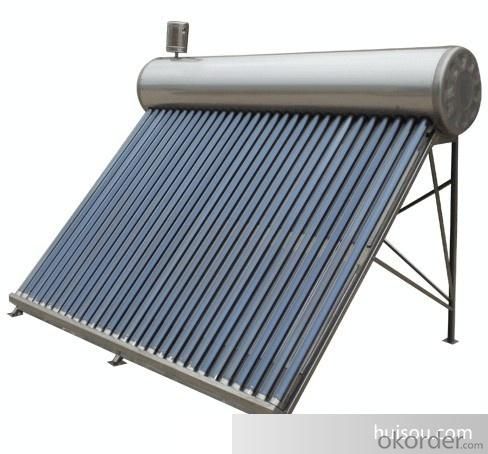
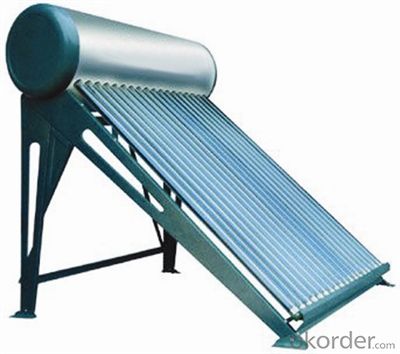
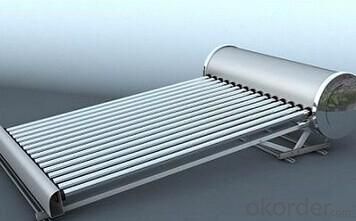
Our Services
1. OEM service
2. Warranty: 5 years
3. Considerable after sale service
Color steel Compact pressure Thermal solar heater
FAQ:
1. What’s the delivery time?
10 days after receiving deposit.
2. How long is the warranty?
5 years for whole system, 1 year for accessory
3. What’s your production capacity?
6000sets/month
4. What’s the MOQ?
1 set.
5. What’s your payment term?
Container: 30% T/T in advance for deposit, 70% T/T before shipment for fist order.
70% T/T after seeing copy of B/L from second order
Sample: 100% T/T in advance
Other choices: L/C at sight.
6. What certifications do you have?
CE, SOLAR KEYMARK, SRCC and etc.
- Q: Can solar collectors be used in areas with limited access to educational resources?
- Yes, solar collectors can be used in areas with limited access to educational resources. Solar collector technology is relatively simple and can be easily understood and implemented with basic training. Additionally, there are numerous online resources and instructional materials available that can be accessed and utilized to educate communities on solar collector installation and maintenance.
- Q: Can solar collectors be used for heating religious buildings?
- Yes, solar collectors can be used for heating religious buildings. Solar thermal systems can effectively capture and convert sunlight into heat energy, which can then be used to warm up the interior spaces of religious buildings. This can help reduce energy costs and reliance on traditional heating systems, making it an environmentally friendly and sustainable option for heating such structures.
- Q: Can solar collectors be used in areas with high levels of dust or dirt?
- Yes, solar collectors can be used in areas with high levels of dust or dirt. However, the efficiency of the solar collectors may be impacted as the accumulation of dust or dirt can reduce the amount of sunlight reaching the surface of the collectors. Regular cleaning and maintenance of the collectors may be necessary to ensure optimal performance in such areas.
- Q: Can solar collectors be used for heating livestock facilities?
- Yes, solar collectors can be used for heating livestock facilities. Solar heating systems can provide a sustainable and cost-effective solution for heating these facilities. Solar collectors, such as solar water heaters or solar air heaters, can be installed to harness the sun's energy and convert it into heat. This heat can then be used to warm the air or water in the livestock facilities, creating a comfortable and healthy environment for the animals. Solar water heaters can be used to heat water for various purposes in livestock facilities, such as providing hot water for cleaning, sterilizing equipment, or even for the animals to drink. Solar air heaters, on the other hand, can be used to warm the air inside the facilities, ensuring that the animals are kept at a suitable temperature during colder months. Using solar collectors for heating livestock facilities brings several advantages. Firstly, it reduces reliance on fossil fuels and contributes to a more sustainable and environmentally friendly operation. Secondly, it can significantly reduce heating costs, as solar energy is abundant and free. Additionally, solar heating systems require minimal maintenance and have a long lifespan, making them a reliable and durable solution. However, it is important to consider the specific requirements and size of the livestock facility when planning to install solar collectors. Factors such as the number of animals, the size of the facility, and the local climate should be taken into account to ensure that the solar heating system is appropriately sized and designed to meet the heating demands. Consulting with solar energy experts or professionals in the field can help in designing an efficient and effective solar heating system for livestock facilities.
- Q: Can solar collectors be used in pharmaceutical manufacturing?
- Solar collectors have the potential to be utilized in pharmaceutical manufacturing. These devices, also referred to as solar thermal systems, are capable of producing heat for a variety of industrial procedures, including pharmaceutical manufacturing. By harnessing the sun's energy, solar thermal systems can heat water or other fluids, which can then be applied in pharmaceutical production for tasks like sterilization, drying, and distillation. Through the implementation of solar collectors, pharmaceutical manufacturing facilities can decrease their reliance on non-renewable energy sources like fossil fuels and significantly diminish their carbon footprint. This can contribute to a more sustainable and eco-friendly production process. Additionally, solar thermal systems can assist companies in reducing their energy expenses by utilizing the abundant and free solar energy available. However, it should be noted that the use of solar collectors in pharmaceutical manufacturing may have limitations depending on the specific requirements of the manufacturing processes. Certain pharmaceutical production procedures may necessitate high temperatures or specific heating methods that may not be achievable with solar thermal systems alone. In such cases, solar collectors can be combined with other heating sources or technologies to meet the necessary requirements. In conclusion, solar collectors have the potential to play a valuable role in pharmaceutical manufacturing by providing clean and renewable heat energy, reducing environmental impact, and potentially lowering energy costs.
- Q: How do solar collectors affect land use?
- Solar collectors have a positive impact on land use as they provide a sustainable and efficient way to generate clean energy without requiring large areas of land. By utilizing rooftops, parking lots, and other existing structures, solar collectors minimize the need for additional land use, thus reducing environmental impact and preserving natural habitats. Furthermore, their installation on unused or underutilized land can also have the added benefit of revitalizing and repurposing such areas.
- Q: Can solar collectors be used in areas with limited technical support?
- Yes, solar collectors can be used in areas with limited technical support. Solar collectors are relatively simple and can be installed and maintained without advanced technical expertise. Additionally, solar energy systems can be designed with user-friendly features and built-in monitoring systems to ensure reliable performance even in areas with limited technical resources.
- Q: Can solar collectors be used in conjunction with other energy sources?
- Yes, solar collectors can be used in conjunction with other energy sources. This is known as a hybrid energy system or hybridization of energy sources. By combining solar collectors with other sources such as wind, hydro, or fossil fuels, it is possible to create a more reliable and efficient energy system. This approach ensures a continuous power supply even when solar energy is unavailable, thus increasing the overall reliability and resilience of the energy system.
- Q: Can solar collectors be used in microgrids?
- Yes, solar collectors can be used in microgrids. Microgrids are small-scale electricity distribution systems that can operate independently or in conjunction with the main grid. Solar collectors, such as photovoltaic panels or solar thermal systems, can generate renewable energy in microgrids, providing a clean and sustainable power source. This helps reduce dependency on traditional fossil fuels and can contribute to the overall energy resilience and reliability of microgrids.
- Q: How do solar collectors impact social equity?
- Solar collectors can have a positive impact on social equity by providing affordable and sustainable energy solutions to communities that may not have access to reliable electricity. They can help reduce energy costs, create job opportunities, and improve the overall quality of life for individuals in underserved areas. Additionally, solar collectors can contribute to reducing carbon emissions and addressing climate change, benefiting everyone regardless of their socio-economic status.
Send your message to us
Pavement Solar Collectors Pressurized Heat Pipe Solar Water Heater System New Designed
- Loading Port:
- China main port
- Payment Terms:
- TT OR LC
- Min Order Qty:
- 1 set
- Supply Capability:
- 6000 set/month
OKorder Service Pledge
OKorder Financial Service
Similar products
Hot products
Hot Searches
Related keywords
